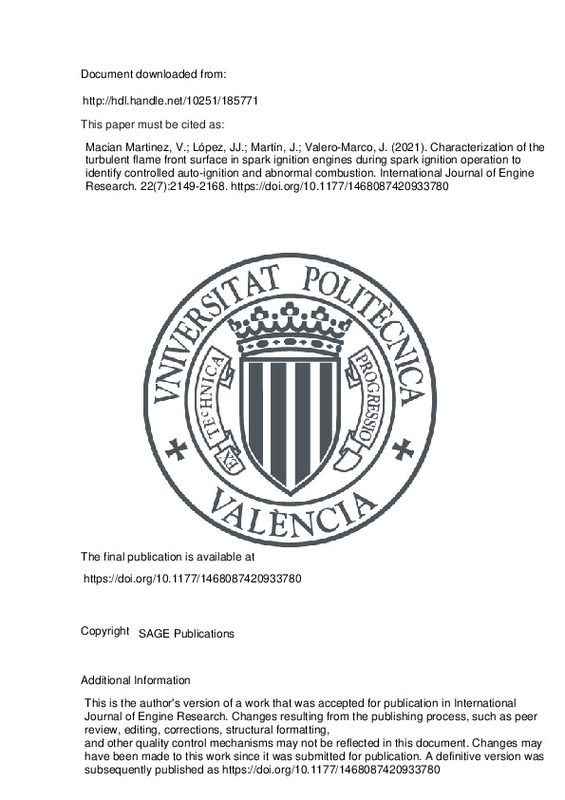JavaScript is disabled for your browser. Some features of this site may not work without it.
Buscar en RiuNet
Listar
Mi cuenta
Estadísticas
Ayuda RiuNet
Admin. UPV
Characterization of the turbulent flame front surface in spark ignition engines during spark ignition operation to identify controlled auto-ignition and abnormal combustion
Mostrar el registro sencillo del ítem
Ficheros en el ítem
| dc.contributor.author | Macian Martinez, Vicente
|
es_ES |
| dc.contributor.author | López, J. Javier
|
es_ES |
| dc.contributor.author | Martín, Jaime
|
es_ES |
| dc.contributor.author | Valero-Marco, Jorge
|
es_ES |
| dc.date.accessioned | 2022-09-09T18:04:51Z | |
| dc.date.available | 2022-09-09T18:04:51Z | |
| dc.date.issued | 2021-07 | es_ES |
| dc.identifier.issn | 1468-0874 | es_ES |
| dc.identifier.uri | http://hdl.handle.net/10251/185771 | |
| dc.description | This is the author's version of a work that was accepted for publication in International Journal of Engine Research. Changes resulting from the publishing process, such as peer review, editing, corrections, structural formatting, and other quality control mechanisms may not be reflected in this document. Changes may have been made to this work since it was submitted for publication. A definitive version was subsequently published as https://doi.org/10.1177/1468087420933780 | es_ES |
| dc.description.abstract | [EN] The combustion diagnostics and subsequent analysis are standardized tools based on the estimation of the heat release law (HRL). From this estimation, the different combustion parameters can be obtained: combustion phasing and duration, heat release rate, and so on. This analysis might be usually enough to study traditional spark ignition (SI) engines. However, with the new upcoming SI engines, this is probably not the case anymore, since different combustion modes can be operated in the same engine, as for instance a combination of SI and controlled auto-ignition (CAI) combustion modes. When different combustion modes are combined, it seems interesting to study in more depth the HRL, trying to get more data and to study the differences among the diverse combustion modes. Toward this end, a methodology to go deeper in the study of the HRL is proposed in this work, consisting of, mainly quantifying and taking into account the most relevant influencing parameters: the fuel properties (mainly its lower heating value), the in-cylinder oxygen content, the density of the burned and unburned zones, the laminar combustion speed, and the turbulence effect. With the proposed methodology, a standard SI combustion, developed by a flame front, can be characterized at any given operating point. This would allow to predict which the combustion developement would be, at this operating point, assuming it to be developed by a flame front. Subsequently, this SI combustion prediction can be compared to the one obtained experimentally, making it possible to identify and analyze abnormal combustion phenomena, as well as to study the differences between a combustion developed by a flame front (SI) and by auto-ignition (CAI). Derived from this work, an alternative equation to experimentally characterize the laminar combustion velocity has also been proposed, in order to improve its applicability in a wider range of fuel/air ratios and dilution degrees. | es_ES |
| dc.description.sponsorship | The author(s) disclosed receipt of the following financial support for the research, authorship, and/or publication of this article: the Spanish Ministry of Science, Innovation and Universities for funding the PhD. studies of Jorge Valero-Marco (contract BES-2016-077610). This work was partly funded by Renault, and by FEDER and the Spanish Government through project TRA2015-67136-R. | es_ES |
| dc.language | Inglés | es_ES |
| dc.publisher | SAGE Publications | es_ES |
| dc.relation.ispartof | International Journal of Engine Research | es_ES |
| dc.rights | Reserva de todos los derechos | es_ES |
| dc.subject | HRL | es_ES |
| dc.subject | CAI | es_ES |
| dc.subject | Controlled autoignition | es_ES |
| dc.subject | SI | es_ES |
| dc.subject | Combustion analysis | es_ES |
| dc.subject | Combustion speed | es_ES |
| dc.subject | Turbulent flame front | es_ES |
| dc.subject.classification | MAQUINAS Y MOTORES TERMICOS | es_ES |
| dc.title | Characterization of the turbulent flame front surface in spark ignition engines during spark ignition operation to identify controlled auto-ignition and abnormal combustion | es_ES |
| dc.type | Artículo | es_ES |
| dc.identifier.doi | 10.1177/1468087420933780 | es_ES |
| dc.relation.projectID | info:eu-repo/grantAgreement/MINECO//TRA2015-67136-R/ES/NUEVOS CONCEPTOS DE COMBUSTION PARA REDUCCION DE CONSUMO, CO2 Y EMISIONES CONTAMINANTES EN MOTORES DE GASOLINA PARA AUTOMOCION/ | es_ES |
| dc.relation.projectID | info:eu-repo/grantAgreement/AEI//BES-2016-077610//AYUDAS PARA CONTRATOS PREDOCTORALES PARA LA FORMACION DE DOCTORES-VALERO MARCO/ | es_ES |
| dc.rights.accessRights | Abierto | es_ES |
| dc.contributor.affiliation | Universitat Politècnica de València. Departamento de Máquinas y Motores Térmicos - Departament de Màquines i Motors Tèrmics | es_ES |
| dc.description.bibliographicCitation | Macian Martinez, V.; López, JJ.; Martín, J.; Valero-Marco, J. (2021). Characterization of the turbulent flame front surface in spark ignition engines during spark ignition operation to identify controlled auto-ignition and abnormal combustion. International Journal of Engine Research. 22(7):2149-2168. https://doi.org/10.1177/1468087420933780 | es_ES |
| dc.description.accrualMethod | S | es_ES |
| dc.relation.publisherversion | https://doi.org/10.1177/1468087420933780 | es_ES |
| dc.description.upvformatpinicio | 2149 | es_ES |
| dc.description.upvformatpfin | 2168 | es_ES |
| dc.type.version | info:eu-repo/semantics/publishedVersion | es_ES |
| dc.description.volume | 22 | es_ES |
| dc.description.issue | 7 | es_ES |
| dc.relation.pasarela | S\428524 | es_ES |
| dc.contributor.funder | AGENCIA ESTATAL DE INVESTIGACION | es_ES |
| dc.contributor.funder | MINISTERIO DE ECONOMIA Y EMPRESA | es_ES |
| dc.contributor.funder | European Regional Development Fund | es_ES |







![[Cerrado]](/themes/UPV/images/candado.png)

